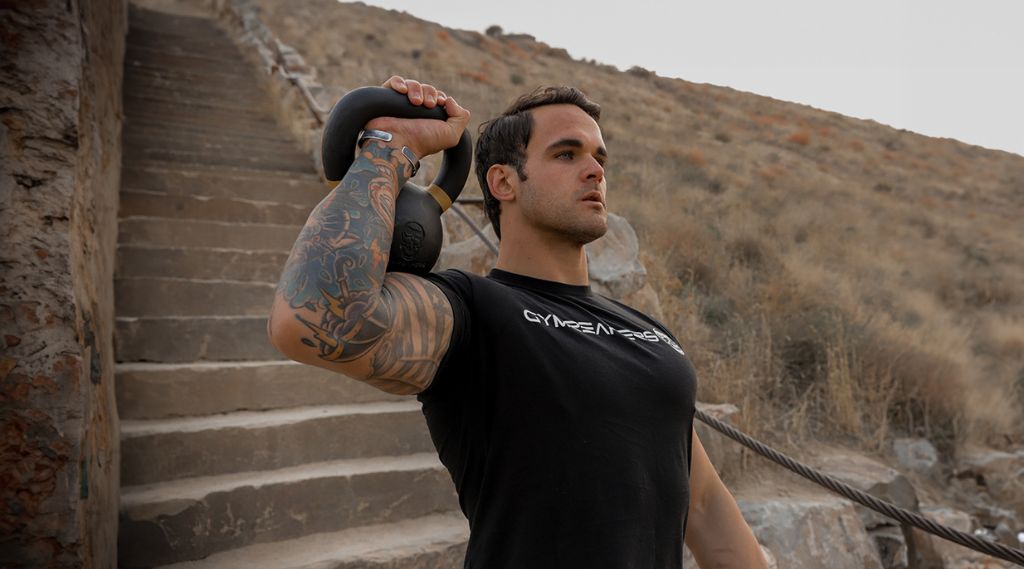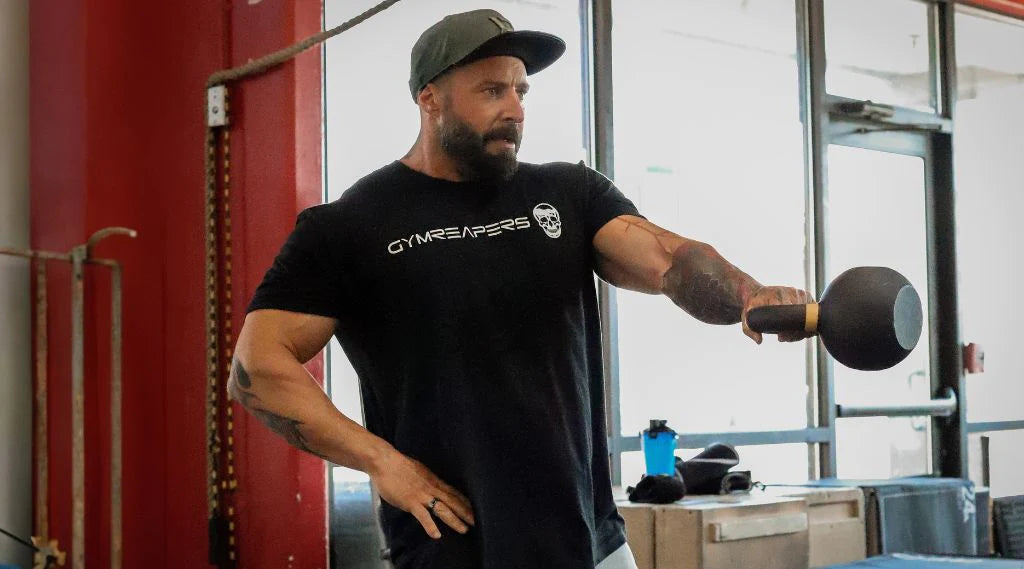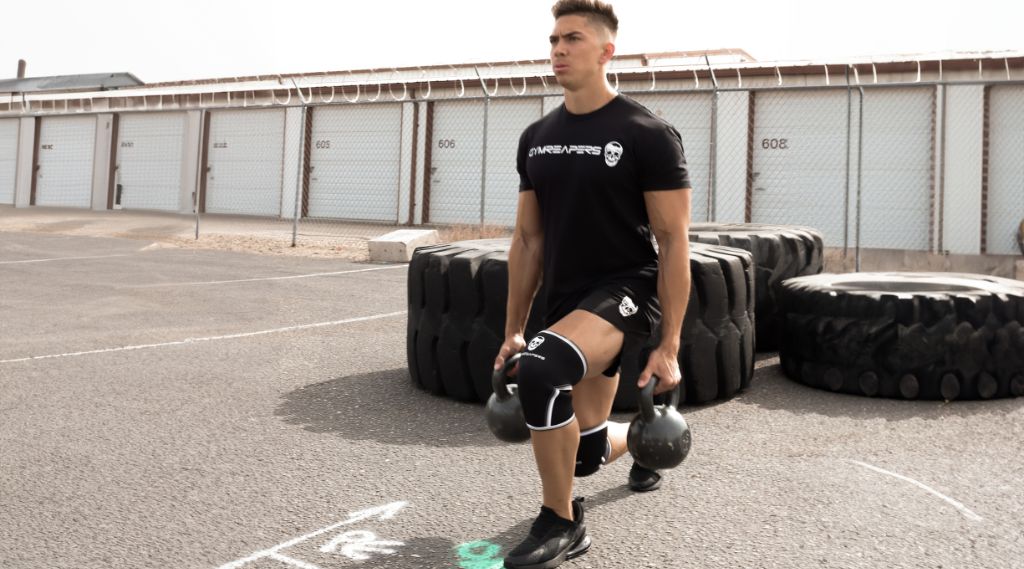As a personal trainer, I often program dynamic movements like the kettlebell hang clean to help lifters develop more strength and power.
Kettlebell hang cleans are a dynamic unilateral (training one side of the body) exercise that trains multiple muscle groups, boosts core stability, builds power and explosiveness, improves muscle coordination, and develops grip strength.
That said, mastering the hang clean is easier said than done, as multiple mistakes could affect the movement’s overall effectiveness and safety.
Key Takeaways
Kettlebell Hang Clean: Anatomy Overview

The kettlebell hang clean trains the following muscles:
Glutes
The glutes are a group of three muscles (maximus, minimus, and medius) that make up the buttocks and play a role in numerous hip-related movements.
The gluteus maximus is the primary muscle involved in the hang clean, as its main function is to drive the hips forward, allowing trainees to stand upright and receive the kettlebell at the top position.
Hamstrings
The hamstrings make up the rear portion of the thighs. Their functions are knee flexion (bending) and hip extension.
During a kettlebell hang clean, the hamstrings assist the glutes in driving the hips forward.
Quadriceps
The quadriceps comprise the front portion of the thighs, and their primary function is knee extension (straightening of the legs).
These muscles play an important role in kettlebell hang cleans by straightening the legs and allowing the trainee to transition from a bent-over to a standing position.
Erector Spinae
The erector spinae is a group of long muscles that run along both sides of the spine. Their primary role is to extend the back and keep the spine in a healthy position.
These muscles play a crucial isometric role (contract without changing position) during the kettlebell hang clean as they engage to maintain a neutral back position.
Latissimus Dorsi
The latissimus dorsi, also known as ‘lats,’ are the largest muscles in the upper body. They cover a significant percentage of the upper and middle back and are involved in some arm and torso motions.
In the context of kettlebell hang cleans, the lats produce some of the force needed to thrust the kettlebell to the top position.
Trapezius
The trapezius is a large muscle that makes up a significant portion of the upper back. It plays crucial roles in shoulder stability and scapular elevation, which are important during the kettlebell hang clean.
Midsection
The abs, obliques, and transverse abdominis promote torso stability and a healthy spinal position. These and other muscles flex isometrically to keep you in a strong position and prevent spinal flexion or hyperextension at any point.
Biceps
The biceps make up the front portion of the upper arms and are primarily responsible for elbow flexion (bending of the arms). These muscles produce some of the force necessary to thrust the kettlebell to the top position.
Deltoids
The deltoids (shoulders) are involved in a wide range of arm motions and play a crucial role in joint stability. These muscles control the kettlebell during the upward swing and promote shoulder and arm stability during the catch phase.
Benefits Of Hang Cleans With A Kettlebell

The benefits of kettlebell hang cleans include:
Power and Explosiveness
The hang clean is a dynamic compound lift that requires fast and controlled execution to accelerate the kettlebell to the top position. As such, it recruits more fast-twitch muscle fibers and improves your ability to generate force quickly, promoting power and explosiveness.
Balance and Stability
The kettlebell hang clean can promote balance and stability in a few ways. First, the movement recruits and strengthens the core, which must engage to promote torso stability.
Second, given the movement’s complex movement pattern, it can improve proprioception (your ability to sense your body, its position, and how it moves). This can also help you control your body more effectively.
Third, the hang clean is a unilateral exercise. It requires you to hold a single kettlebell in one hand, which means the stability requirements are greater, forcing you to work harder to maintain your balance.
Muscle Growth
As discussed above, the kettlebell hang clean recruits multiple major muscle groups, which could lead to more efficient training and hypertrophy.
Core Strength
The core musculature (abs, obliques, erector spinae, glutes, etc.) engages to promote stability and generate some of the force necessary to thrust the kettlebell to the top. As such, the kettlebell hang clean is an effective core-strengthening movement.
Muscle Coordination
Given its complex movement pattern, the hang clean takes time to master, but the advantage is that the movement promotes muscle coordination.
Trainees must move various parts of their body in a coordinated way and learn to blend slower and quicker movements to execute each rep.
Overloading Potential
While it’s best to use a light kettlebell when learning the hang clean, the potential for overload is quite good. Trainees can gradually work up to heavier kettlebells as they build strength and power, and improve their skills with the movement.
Grip Strength
Kettlebells have thick handles, which are more difficult to grip. As such, trainees must exert more force to hold onto the weight, directly translating to a firmer grip and more muscular forearms.
How To Do A Kettlebell Hang Clean
Follow these steps to perform the kettlebell hang clean properly:
-
Stand with your feet shoulder-width apart, your toes pointing slightly out, and a kettlebell on the floor before you.
-
Lean forward and grab the kettlebell with your right hand.
-
Stand up and have the kettlebell in front of your body with your palm facing you and your arm extended.
-
Retract your shoulder blades, take a deep breath, and engage your abs.
-
Initiate the swing by bending your knees slightly and pushing your buttocks back to lower the kettlebell between your legs. The movement should be small and quick.
-
Immediately reverse the direction, drive your hips forward, and extend your hips as you pull the kettlebell up and shrug your shoulders. Keep your elbow close to your body and allow your forearm to rotate around the weight.
-
As the kettlebell reaches shoulder level, quickly rotate your wrist so the weight ends up on the outside of your arm and lands in the crook of your arm. Exhale just as you catch the weight. Your palm should be facing forward.
-
Swing the kettlebell back to the bottom position. Keep your elbow close to your body and control the descent instead of letting the weight drop to hip level.
- Once finished training one side, set the kettlebell on the floor, grab it with the opposite hand, and repeat for the same number of reps.
7 Common Mistakes With Kettlebell Hang Cleans

To maximize the benefits of the kettlebell hang clean and reduce your risk of injury, avoid the following mistakes.
Mistake #1: Lifting Mostly With the Arms
The kettlebell hang clean is primarily a lower body exercise, and the arms serve to guide the weight and control it during the catch phase.
Lifting mainly with the arms is a common mistake that limits trainees’ performance and generally happens because of a lack of power from the lower body when initiating the movement.
“The kb clean, just like all the other deadlift movements, comes from the hips. It is that explosive little HIP SNAP that sends the kettlebell up and on its way to the chest. It is not an arm exercise. You could have arms like pencils and still clean a heavy kettlebell.”
-Greg Brookes, personal trainer, and fitness writer
How To Fix
Focus on the dip and hip drive at the start of each repetition to generate enough momentum to thrust the kettlebell to the top position. Use your arms to guide the weight and get it to the correct top position.
Mistake #2: Forgetting About the Core
The kettlebell hang clean is a technical lift with many moving parts, so trainees are often worried about getting the kettlebell to the catch position, neglecting other aspects of the lift.
The problem with being so focused on elevating the kettlebell is that it makes you ignore other essential parts of the lift, such as maintaining a tight midsection for explosive and controlled execution.
How To Fix
Take a deep belly breath and engage your abs at the start of each set. Maintain that rigid position until you set the weight on the floor to stay safe and reduce the injury risk.
If you can’t maintain tension in your midsection because you’re too focused on the path of the kettlebell, then choose a lighter weight until you get more comfortable with the movement.
Mistake #3: Swinging the Kettlebell too Far Forward
Swinging the weight too far in front of your body makes it more challenging to maintain balance because the kettlebell will pull you forward.
As a result, you might not be able to lift as much weight safely and the kettlebell is more likely to crash on your wrist and forearm in the catch position.
How To Fix
The path of the kettlebell to the top position should be more vertical than horizontal. You should only pull the weight forward to clear enough room to avoid hitting yourself; anything beyond that would make the movement less efficient.
Drive through your hips at the start of the repetition, and keep your elbow close to your body. Doing so will make lifting the kettlebell in a relatively straight line easier and allow for a smoother catch.
Mistake #4: Skipping the ‘Dip’
The dip is essential to the kettlebell hang clean because it allows you to produce the necessary hip drive to generate momentum. Skipping that portion of the lift forces you to use your upper body muscles to hoist the weight, turning the exercise into a modified front raise.
How To Fix
Initiate each rep by bending your knees several degrees and pushing your buttocks back while keeping your chest out. This allows you to engage your posterior chain and gives you room to extend your hips to generate the necessary force to complete each rep.
Mistake #5: Incorrect Catch
Not catching the kettlebell correctly can be quite unpleasant because it can place more stress on your elbows and shoulders, as well as bruise your forearms.
How To Fix
The kettlebell should land softly in the front rack position and rest against the crook of your arm––right in the middle of the forearm and bicep.
To ensure a ‘soft landing,’ keep your bicep and shoulder engaged to guide the kettlebell as it moves to the top position and quickly rotate your wrist to guide the kettlebell into the receiving position rather than letting the kettlebell go up and over to the rack position.
Mistake #6: Rounding the Lower Back
Lower back rounding is less common during kettlebell hang cleans than other hip hinge activities because the degree of hip flexion is smaller. That said, there is still a risk for people unfamiliar with the hip hinge.
Instead of pushing the buttocks back to load the hamstrings, some trainees might simply round their lower back to swing the kettlebell between the legs.
How To Fix
Keep your chest out, bend your knees, and push your buttocks back at the start of each repetition. Be mindful of your lower back position, and make sure you feel the tension in your hamstrings and glutes.
Mistake #7: Forgetting to Breathe
The kettlebell hang clean is difficult to master because it combines several movement patterns and cues. As such, trainees can often feel overwhelmed and forget to breathe, which inevitably limits their performance.
How To Fix
Take a deep breath and squeeze your abs before initiating each repetition and exhale forcefully as you receive the kettlebell at the top position.
Best Kettlebells For Hang Cleans

One notable advantage is that these kettlebells have a smooth finish, which means less friction during training. This allows you to rotate your wrist at the right time to get the kettlebell in the correct position while keeping calluses at bay.
Another benefit of these kettlebells is that you can pick from many weights, ranging from 4 to 40 kilograms (9 to 88 lbs). That means you can select the weight that fits your current abilities across many exercises.













Leave a comment
All comments are moderated before being published.
This site is protected by hCaptcha and the hCaptcha Privacy Policy and Terms of Service apply.